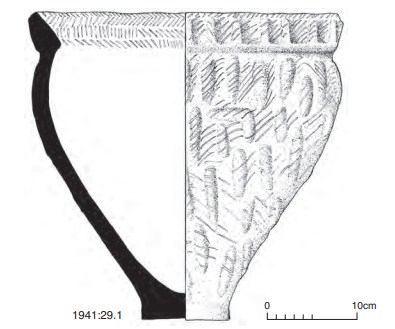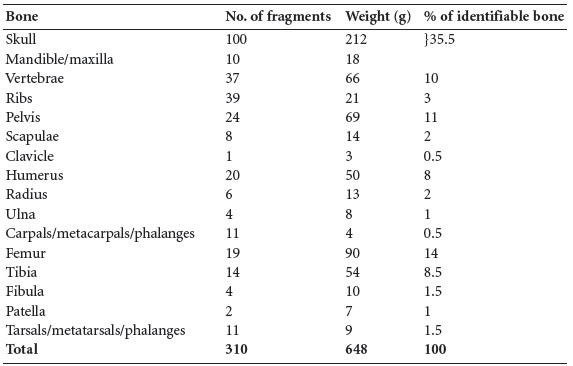County: Limerick Site name: BALLINLYNA UPPER, CO. LIMERICK
Sites and Monuments Record No.: SMR LI056-037 Licence number: E1110
Author: D.F. OSHAUGHNESSY
Site type: Early Bronze Age graves
Period/Dating: —
ITM: E 568241m, N 620446m
Latitude, Longitude (decimal degrees): 52.334710, -8.465997
Introduction
In March 1941 a polygonal cist containing an encrusted urn and a cremation was discovered during night ploughing near Kilfinnane, Co. Limerick. The cist was uncovered approximately 0.15m below ground level when the plough struck its capstone (Pl. 35). An investigation was carried out the following day by Mr D.F. O’Shaughnessy, a member of the North Munster Antiquarian Society, who then reported the find to the NMI. During Mr O’Shaughnessy’s investigation an attempt was made to lift the urn from the cist but this resulted in the urn being broken. The fill of the cist was removed by Mr O’Shaughnessy, but nothing further was found. As the site was not investigated by NMI personnel, this report is based on Mr O’Shaughnessy’s account. The human remains were examined by Laureen Buckley.

Location (Fig. 3.97)
The site was in the townland of Ballinlyna Upper, approximately 2km south of Kilfinnane village, south-east Co. Limerick.162 It lay on the south-western slopes of Benyvoughella Hill (296m), at an altitude of c. 200–210m above sea level, in a field known locally as ‘Moat Field’.
Description of site
The cist was polygonal in shape, with its longer axis running east/west. Internally it measured 0.56m long by 0.55m wide by 0.46m deep (Fig. 3.98). It was composed of seven slabs set on edge forming the cist walls. There is no evidence in the plan for packing stones around the outside of


the cist, but at the eastern end of the cist two stones were placed flat on the side stones in order to equalise the height of the walls. The cist was covered with an irregularly shaped capstone measuring 0.94m long by 0.64m wide. A small portion of the eastern side of the capstone had been fractured, probably during the discovery of the cist. The cist was apparently paved with at least one slab. The pit dug to receive the cist is not noted in O’Shaughnessy’s report. The grave contained a cremation, which represented the remains of an adult male and a juvenile aged 3–5 years at death (1941:29.2), contained within an inverted encrusted urn.
Encrusted urn, 1941:29.1163 (Fig. 3.99)
The following description of the urn is given by Kavanagh (1973, 552, fig. 22, no. 50). ‘Rim bevelled internally and patterned with grooves to give a haphazard herring-bone pattern. Externally this area is delimited by an applied cordon from which rises a series of vertical ribs arranged at 4 to 5cm intervals. Below this, and covering the whole vessel, the same motif of short vertical ribs is arranged in alternating rows. The applied ornament ceases about 2cm from the base which is very narrow and slightly splayed. The pattern of applied ornament on this vessel is unusual. Its closest parallel is to be found on the vessel from Labbamolaga, Co. Cork, where the ribs arranged horizontally are found all over the vessel. The secondary decoration consists of short scored lines, covering the whole vessel, but occurring less frequently in the lower half. The ware is thick and compact. Where the applied ornament has fallen away an orange background is revealed; but the overall colour is buff.’
Dimensions: H 33.8cm; ext. D rim 33.3cm; D base 10cm.
Comment
A sample of carbonate from the cremated bones gave a date of 3660±50 BP, which calibrates to 2150–1890 BC at 2 sigma. Brindley (2007, 268) in discussing encrusted urns places their development between 2000 and 1700 BC, with the urn from Ballinlyna categorised as belonging to stage 1 of the developmental sequence, which is dated from 2000/1980 BC to 1920 BC.164
HUMAN REMAINS
LAUREEN BUCKLEY
Introduction
Sample 1941:29.2 consisted of 900 fragments of cremated bone, weighing a total of 874g. The bone was stained by soil but the basic colour was white, with one or two slightly blue/grey fragments. Most fragments have a chalky texture. The long bones were warped and fissured but the vertebral bodies had hardly changed at all.
Table 3.45—Fragmentation of bone, 1941:29.2.

Table 3.45 shows the fragmentation of the sample, with the largest fragment being 115mm in length. It can be seen that nearly 70% of the sample consists of very large fragments, and that the large-sized fragments more than 15mm in length make up nearly 90% of the sample. The sample may have been disturbed to a very little extent but it is possible that the smaller fragments were not collected, as the weight is still below that normally found from a full adult cremation.
Identifiable bone
As there was a high proportion of large fragments, a relatively high percentage of bone could be identified. A total of 648g (74% of the total bone) was identified. The amount and proportion of the identified bone is shown in Table 3.46.
Table 3.47 summarises the main parts of the skeleton identified from this sample. It can be seen that while the proportion of skull is higher than expected, the axial skeleton is almost exactly what it should be but the proportion of upper and lower limbs is lower than expected.
The limbs may be slightly lower than normal because very few of the bones of the hands and feet were collected. It seems to have been mainly the bigger bones that were collected.
Table 3.46—Proportion of identified bone, 1941:29.2.

Table 3.47—Summary of identified bone, 1941:29.2.

Identifiable fragments
Skull
There were very large fragments of the squamous frontal bone with the right side and middle of the bone present. In one fragment the crista frontalis was visible. The right orbit and supraorbital part and glabella were also visible, and the supraorbital ridges were of the male type. There were large fragments of the parietal bone, including the posterior part of the right parietal bone. The sagittal suture was open. The mastoid area and part of the squamous area of the left temporal bone were present, as well as the mastoid areas of two other temporal bones. There were fragments of a left and a right zygomatic bone and part of another. The body and left greater wing of sphenoid were also present.
Mandible, maxilla
Part of a right ramus from an adult mandible as well as a fragment of a left ramus and mandibular condyle were present. There was a fragment from the interior surface of the body with the genial tubercle present. There was also a left side of a juvenile mandible. An almost complete adult maxilla was present as well as a juvenile maxilla.
Dentition
(1) Adult: the following sockets were present:

The roots of a premolar and two other roots were present.
(2) Juvenile: the following sockets were present:

The roots of one deciduous molar were present. The crowns of the permanent canines were in situ and they had been almost completely formed. This would place the juvenile in the 3–5- year-old age range.
Vertebrae
The dens articulation area from a first cervical vertebra, one lower cervical vertebra and a few fragments of articular surfaces remained from the cervical vertebrae. The thoracic vertebrae consisted of twelve bodies, some with the superior part of the neural arch still attached, and there were a few other articular surfaces. Five lumbar vertebral bodies were present and some had the superior articular surfaces attached.
Ribs
There were several fragments of shaft, and at least four ribs from the right side had their tubercles visible.
Pelvis
There were several fragments of ilium, including the anterior part of the right ilium as well as the posterior part. The auricular surface of the left ilium was present and there were some fragments of acetabulum. A left and a right ischium were present, and there was also an almost complete first sacral vertebra.
Clavicle
The lateral end of the right clavicle was present.
Scapula
The glenoid fossa and acromial spine of the left scapula were present, as well as the base of the acromion of the right scapula. There were a few other fragments of lateral border.
Humerus
The distal end of the left humerus with the fused trochlea was present. There was also a fragment of the distal end of the right humerus. Proximal ends of shafts from a left and a right bone were present, as well as one fragment of neck and two proximal ends.
Radius
The proximal half and proximal third of a left and a right radius were present and there were a few other fragments of shaft, including a fragment from the distal end of a right bone.
Ulna
This consisted of shaft fragments and one proximal end.
Carpals, metacarpals, phalanges
The right lunate, a fragment of a scaphoid and a few metacarpal shafts were present. There were also two proximal, one distal and three middle phalanges.
Femur
A large fragment from the neck of the right femur was present. The lesser trochanter and part of the shaft of the left femur were present and there were several fragments of femur shaft. There were also two fragments of proximal joint surfaces and two fragments from the distal joint surface.
Tibia
Several fragments of shaft were present, including the posterior shaft near the proximal end with the nutrient foramen visible. There were fragments from the anterior surface of the bone, including the tubercle from the left bone.
Fibula
This consisted of fragments of shaft only.
Patella
A left and a right patella were present.
Tarsal, metatarsals, phalanges
Fragments of calcaneum and cuneiform were present, as well as four metatarsal shafts and one of the distal foot phalanges.
Juvenile bones
Including the juvenile mandible and maxilla already described, there was a total of 13g of juvenile bone. Other bones present include a second cervical vertebra, fragments of femur and fibula shaft, a few rib fragments and one of the hand phalanges.
Minimum number of individuals
There were at least two individuals present. One was an adult male and one was a juvenile aged three to five years of age.
Summary and conclusions
This sample consisted of 874g of efficiently cremated bone. The bone was mainly in large fragments, and whilst this indicates that it was probably not deliberately broken up as part of the cremation ritual, it also suggests that the smaller fragments may not have been collected from the cist. Most skeletal elements were present, although there was a low proportion of hand and foot bones. Again this is more likely to be because they were not collected from the cist rather than not collected from the pyre. The proportion of skull was twice what was expected and this usually occurs when more than one individual is present. In fact two individuals, an adult male and a juvenile aged 3–5 years, were present. No pathology was noted on the bones.
162. Parish of Kilfinnane, barony of Coshlea. SMR LI056-037——. IGR 168284 120395.
163. This urn is currently on loan to Limerick City Museum.
164. GrA-14602.